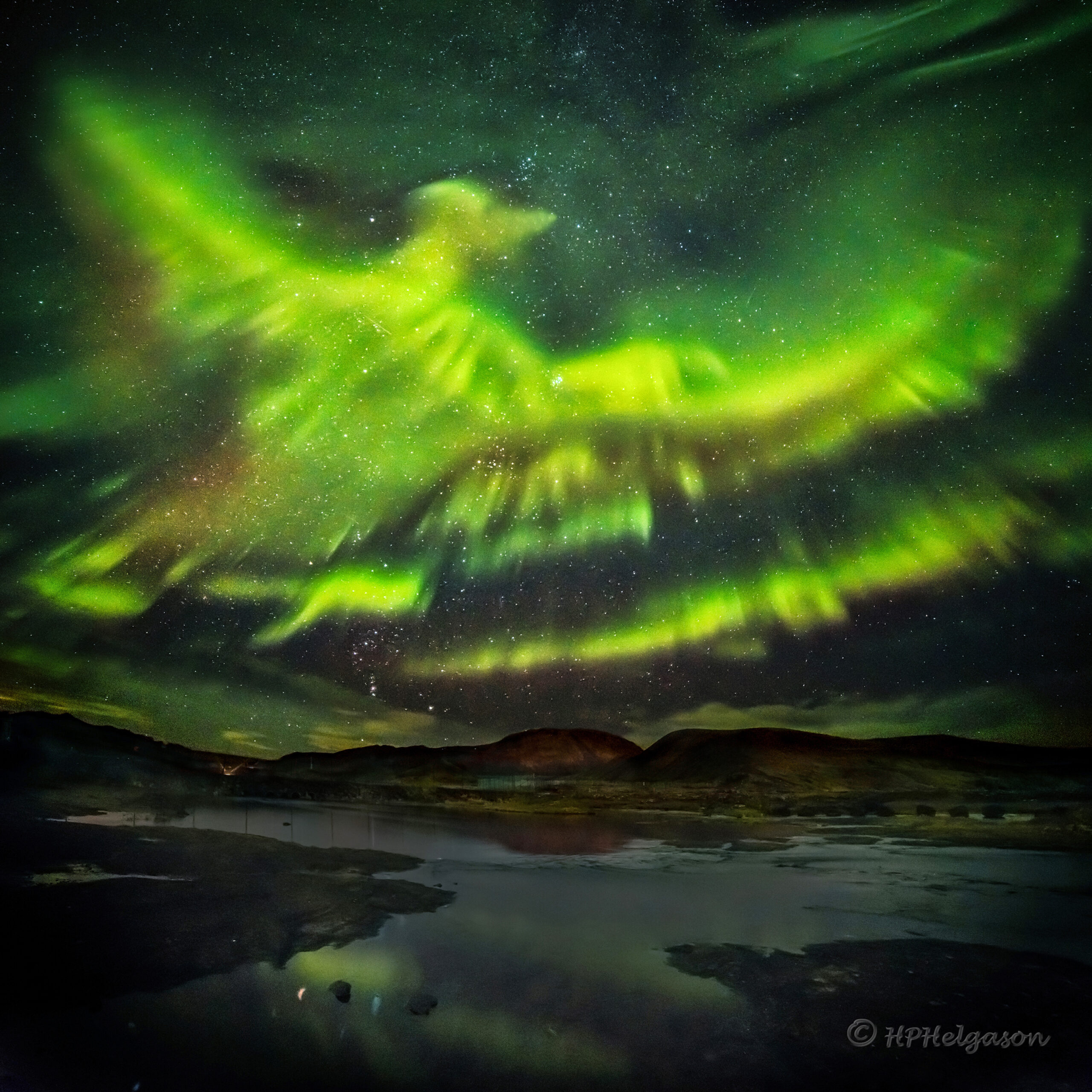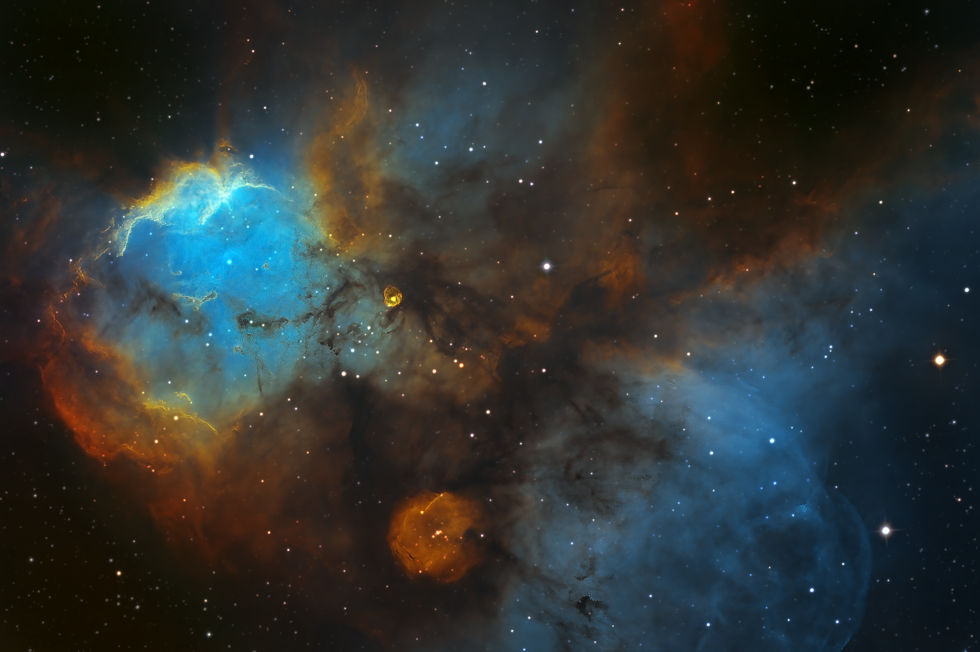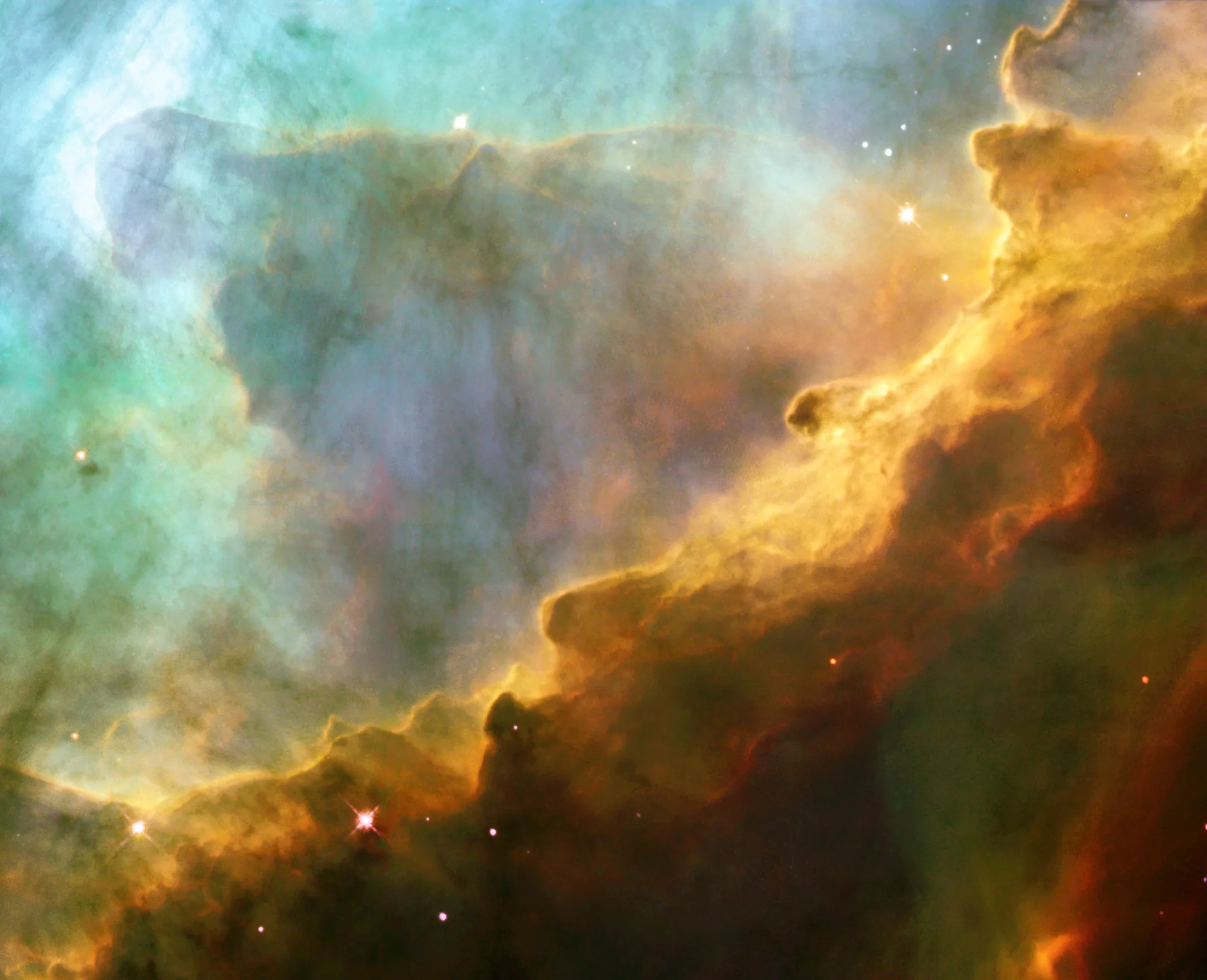Blog

By 3:30 am in Iceland, on a quiet September night, much of that night’s auroras had died down. Suddenly, unexpectedly, a new burst of particles streamed down from space, lighting up the Earth’s atmosphere once again. This time, surprisingly, pareidoliacally, the night lit up with an amazing shape reminiscent of a giant phoenix. With camera equipment at the ready, two quick sky images were taken, followed immediately by a third of the land. The mountain in the background is Helgafell, while the small foreground river is called Kaldá, both located about 30 kilometers north of Iceland’s capital Reykjavík. Seasoned skywatchers will note that just above the mountain, toward the left, is the constellation of Orion, while the Pleiades star cluster is also visible just above the frame center. The 2016 aurora, which lasted only a minute and was soon gone forever — would possibly be dismissed as a fanciful fable — were it not captured in the featured, digitally-composed, image mosaic.

Hal Blaine (born Harold Simon Belsky; February 5, 1929 – March 11, 2019) was an American drummer and session musician, thought to be among the most recorded studio drummers in the music industry, claiming over 35,000 sessions and 6,000 singles. His drumming is featured on 150 US top 10 hits, 40 of which went to number one.
Born in Holyoke, Massachusetts, Blaine moved with his family to California in 1943 and began playing jazz and big band music before taking up rock and roll session work. He became one of the regulars in Phil Spector‘s de facto house band, which Blaine nicknamed “the Wrecking Crew“. Some of the records Blaine played on include the Ronettes‘ single “Be My Baby” (1963), which contained a drum beat that became widely imitated, as well as works by popular artists such as Frank Sinatra, Elvis Presley, the Beach Boys, Simon & Garfunkel, the Carpenters, Neil Diamond, and the Byrds.
Blaine’s workload declined in the 1980s as recording and musical practices changed. In 2000, he was among the inaugural “sidemen” inductees to the Rock and Roll Hall of Fame. In 2007 he was inducted into the Musicians Hall of Fame and Museum as a member of the Wrecking Crew and in 2018 he received a Grammy Lifetime Achievement Award.
Blaine was born Harold Simon Belsky to Jewish Eastern European immigrants, Meyer and Rose Belsky (née Silverman), in Holyoke, Massachusetts, United States.
more...René Thomas (25 February 1926 – 3 January 1975) was a Belgian jazz guitarist.
In the early 1950s, he moved to Paris, France, and became part of the modern jazz scene, playing in the style of Jimmy Raney. He spent brief periods in the United States from 1958 to 1962. Back in Europe, he toured and recorded with Chet Baker, Bobby Jaspar, Kenny Clarke, Eddy Louiss, Stan Getz, Lucky Thompson, Sonny Criss, Jacques Pelzer, Lou Bennett, Charles “Lolo” Bellonzi, and Ingfried Hoffmann.
Thomas died of a heart attack in Santander, Spain, at the age of 48 on 3 January 1975.
more...Oumou Sangaré (Bambara: Umu Sangare; born 25 February 1968 in Bamako) is a Grammy Award-winning Malian Wassoulou musician of Fulani or Fula descent. She is often referred to as “The Songbird of Wassoulou”. Wassoulou is a historical region south of the Niger River, where the music descends from age-old traditional song, often accompanied by a calabash.
more...George Harrison MBE (25 February 1943 – 29 November 2001) was an English musician, singer and songwriter who achieved international fame as the lead guitarist of the Beatles. Sometimes called “the quiet Beatle”, Harrison embraced Indian culture and helped broaden the scope of popular music through his incorporation of Indian instrumentation and Hindu-aligned spirituality in the Beatles’ work. Although the majority of the band’s songs were written by John Lennon and Paul McCartney, most Beatles albums from 1965 onwards contained at least two Harrison compositions. His songs for the group include “Taxman“, “Within You Without You“, “While My Guitar Gently Weeps“, “Here Comes the Sun” and “Something“. Harrison’s earliest musical influences included George Formby and Django Reinhardt; subsequent influences were Carl Perkins, Chet Atkins and Chuck Berry.
By 1965, he had begun to lead the Beatles into folk rock through his interest in Bob Dylan and the Byrds, and towards Indian classical music through his use of Indian instruments, such as the sitar, which he had become acquainted with on the set of the film Help! He played sitar on numerous Beatles songs, starting with “Norwegian Wood (This Bird Has Flown)“. Having initiated the band’s embrace of Transcendental Meditation in 1967, he subsequently developed an association with the Hare Krishna movement. After the band’s break-up in 1970, Harrison released the triple album All Things Must Pass, a critically acclaimed work that produced his most successful hit single, “My Sweet Lord“, and introduced his signature sound as a solo artist, the slide guitar. He also organised the 1971 Concert for Bangladesh with Indian musician Ravi Shankar, a precursor to later benefit concerts such as Live Aid. In his role as a music and film producer, Harrison produced acts signed to the Beatles’ Apple record label before founding Dark Horse Records in 1974. He co-founded HandMade Films in 1978, initially to produce the Monty Python troupe’s comedy filmThe Life of Brian (1979).
Harrison released several best-selling singles and albums as a solo performer. In 1988, he co-founded the platinum-selling supergroup the Traveling Wilburys. A prolific recording artist, he was featured as a guest guitarist on tracks by Badfinger, Ronnie Wood, and Billy Preston, and collaborated on songs and music with Dylan, Eric Clapton, Ringo Starr, and Tom Petty. Rolling Stone magazine ranked him number 31 in their 2023 list of greatest guitarists of all time. He is a two-time Rock and Roll Hall of Fame inductee – as a member of the Beatles in 1988, and posthumously for his solo career in 2004.
Harrison’s first marriage to model Pattie Boyd in 1966 ended in divorce in 1977. In the following year he married Olivia Arias, with whom he had a son, Dhani. A lifelong cigarette smoker, Harrison died of numerous cancers in 2001 at the age of 58, two years after surviving a knife attack by an intruder at his home, Friar Park. His remains were cremated, and the ashes were scattered according to Hindu tradition in a private ceremony in the Ganges and Yamuna rivers in India. He left an estate of almost £100 million.
more...Ida M. Cox (Prather; February 26, 1888 or 1896 – November 10, 1967) was an American singer and vaudeville performer, best known for her blues performances and recordings. She was billed as “The Uncrowned Queen of the Blues”.
Cox was born Ida M. Prather, the daughter of Lamax and Susie (née Knight) Prather in Toccoa, then Habersham County, Georgia, and grew up in Cedartown, Polk County, Georgia. Many sources give her birth date as February 26, 1896, but the researchers Bob Eagle and Eric LeBlanc have suggested she was born in 1888, and noted other evidence suggesting 1894.
more...1956 – In Cleveland, OH, police invoked a 1931 ordinance barring people under the age of 18 from dancing in public unless accompanied by an adult.

RCW 16 is an Ha-emission region in the southern Milky Way. NGC 2467, also known as the “Skull and Crossbones Nebula”, is a star-forming region within RCW 16.

Nicholas Christian Hopkins (24 February 1944 – 6 September 1994) was an English pianist and organist. He performed on many popular and enduring British and American rock music recordings from the 1960s to the 1990s, most notably on songs recorded by the Rolling Stones, the Kinks, the Who, the Beatles, the Steve Miller Band, Jefferson Airplane, Rod Stewart, George Harrison, John Lennon, Paul McCartney, Ringo Starr, The Hollies, Cat Stevens, Carly Simon, Harry Nilsson, Joe Walsh, Peter Frampton, Jerry Garcia, Jeff Beck, Joe Cocker, Art Garfunkel, Badfinger, Graham Parker, Gary Moore, Quicksilver Messenger Service and Donovan. He is widely considered to be one of the greatest studio pianists in the history of popular rock music. Hopkins died on 6 September 1994, at the age of 50, in Nashville, Tennessee, from complications resulting from intestinal surgery related to his lifelong battle with Crohn’s disease. At the time of his death, he was working on his autobiography with Ray Coleman.
more...David “Fathead” Newman (February 24, 1933 – January 20, 2009) was an American jazz and rhythm-and-blues saxophonist, who made numerous recordings as a session musician and leader, but is best known for his work as a sideman on seminal 1950s and early 1960s recordings by Ray Charles.
The AllMusic Guide to Jazz wrote that “there have not been many saxophonists and flutists more naturally soulful than David ‘Fathead’ Newman.” Newman was a leading proponent of the “Texas Tenor” saxophone style, a big-toned, bluesy approach popularized by jazz tenor players from that state.
Newman was born in Corsicana, Texas, United States, on February 24, 1933, but grew up in Dallas, where he studied first the piano and then the saxophone.
more...The Celestial Antiquity Event is scheduled on 3-28-24 at UWEC Eau Claire, WI at 7pm. The location of the event will be at Gartner Hall in Haas Fine Arts building on campus of UWEC.



Friday 2-23-24 630pm Shabbat for the Soul service with Jennifer Struss-Klein, Tami Morse and mick laBriola. February is Jewish Disability, Awareness, Acceptance and Inclusion (JDAIM) Month. Mount Zion member, Shelley Robbins, will be our pulpit speaker.
more...
This supernova shock wave plows through interstellar space at over 500,000 kilometers per hour. Centered and moving upward in the sharply detailed color composite its thin, bright, braided filaments are actually long ripples in a cosmic sheet of glowing gas seen almost edge-on. Discovered in the 1840s by Sir John Herschel, the narrow-looking nebula is sometimes known as Herschel’s Ray. Cataloged as NGC 2736, its pointed appearance suggests its modern popular name, the Pencil Nebula. The Pencil Nebula is about 800 light-years away. Nearly 5 light-years long it represents only a small part of the Vela supernova remnant though. The enormous Vela remnant itself is around 100 light-years in diameter, the expanding debris cloud of a star that was seen to explode about 11,000 years ago. Initially, the section of the shock wave seen as the Pencil nebula was moving at millions of kilometers per hour but has slowed considerably, sweeping up surrounding interstellar material.

More Posts
- Happy Veterans Day 2019
- Rhythm Roots Workshop Residency
- The Cosmos with Alnitak, Alnilam & Mintaka
- Lavern Baker Day
- Hank Garland Day
- Ernestine Anderson Day
- Mose Allison Day
- World Fusion with Apichat Pakwan
- Daily Roots with Larry Marshall
- Edmund Fitzgerald by Gordon Lightfoot
- Edmund Fitzgerald 44th Anniversary
- Mercury Transit 11-11-19
- The Cosmos with M16
- Hubert Laws Day
- Russell Means Day
- Andrew Cyrille Day
- Paul Bley Day
- George Mojo Buford Day
- World Music with Vishnu Gobind Jog
- Daily Roots with The Garifuna Collective